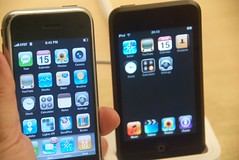 Image via CrunchBase
Image via CrunchBaseDropBox Review Summary
Source: Macworld.com
Put simply, Dropbox is an amazingly useful combination of a Web service and a Mac OS X program that work together to make your data accessible from anywhere and to keep it synchronized between your computers.
Once you've installed the Dropbox application and set up a Dropbox account, anything you place in a special Dropbox folder on your Mac is automatically copied to the Dropbox servers, as well as to any other Macs you've set up with that Dropbox account.
If this sounds a bit like the iDisk feature of Apple's MobileMe service, that's because it's similar - except that Dropbox is fast and reliable.
Dropbox is also smarter about copying files: It transfers smaller files before larger ones, copies only the parts of each file that have changed, and compresses all data for the trip.
And Dropbox is better about handling sync conflicts - if the same document is modified on two computers at the same time, Dropbox keeps both copies, adding a "oeconflicted" message to the name of one.
For example, I personally use my Dropbox folder for storing all my in-progress documents, letting me work on those documents from any of my Macs.
I can also access those documents using the Dropbox app for iPhones and iPads, and I can even edit them on my iOS devices using apps such as the Elements text editor.
In addition, many Mac programs, such as TextExpander and 1Password, can use Dropbox to ensure all your Macs have the same settings and data; and because your Dropbox folder is a standard Finder folder, you can use Automator or a utility such as Hazel to automate task across your Macs.
Strengths:
Dropbox offers hassle-free access to synced files on all of your machines.
An amazing feature is that you can also retrieve deleted files, so this product also provides a versioned backup solution.
Dropbox offers a generous 8GB of free storage space, which can be upgraded to 50GB or 100GB plans for a monthly fee.
Weaknesses:
Some users may find 8GB of storage space is rather limiting, but this can be upgraded for a monthly fee.
Overall:
Dropbox truly is one of those amazing must install applications.
More importantly, customer service on the forums is excellent.
Overall:
I've only been using Dropbox for about 3 months now, but I can say, hand on heart, that it is one of the best pieces of software that I have ever used in my life.
Dropbox is an indispensable part of my workflow, and it keeps getting better and better with each release.
Now that it handles most Mac metadata properly, it integrates seamlessly with the Finder; and with Web-browser access, as well as Dropbox software—and Dropbox-enabled third-party programs—available for OS X, Windows, Linux, and iOS, you can access and edit your data from anywhere and any device.
I have yet to find an easier way to share data with other computers and other people. And did I mention the outstanding DropBox documentation?
Note in the PC world review they list "but forces you to do all your sync management from one unmovable folder" This is not true.
Related Resources:
Concepts:
dropbox, folder, Mac, reviews, sync, feature, storage, backup, Networking, Macworld, computers, account, app, Mice, Automator.



















